What Are Advantages of eCommerce Business?
An eCommerce business offers many benefits compared to traditional brick-and-mortar stores, including:
- Unlimited access and reach
- Reduced overhead costs
- Lower barriers to entry
- Global customer base
- Improved shopping experience
Unlimited access and reach
Unlike physical stores with limited opening times and customer footfall, an eCommerce store is available around the clock. This lets customers shop whenever and wherever, as long as they have an internet connection.

To additionally extend your (organic) reach, you can use pay-per-click advertising. The name is self-explanatory: you only pay for clicks. It is easy to control your advertising budget which is important especially when you are starting your eCommerce business.
But do you REALLY know how to optimize PPC campaigns on Amazon, eBay, Google, Bing and so on?
There are many ad optimization tools out there. But if you decide to start selling via Amazon and / or eBay give Adspert a try: the Amazon PPC optimization tool on the market powered by best ad-tech AI. What is so great about Adspert? It maximizes your profit, not just sales!
Reduced overhead costs
Traditional stores require significant costs for leasing, staff wages, and operational expenses, but for an eCommerce business, these costs are a lot less or even eliminated.
Improved shopping experience
Online shoppers enjoy more convenience than those who shop in physical stores, with features such as automated checkouts, one-click purchases, comparison tools, and product reviews making the process smoother and quicker than ever before.

Lower barriers to entry
Without needing to rent physical premises or hire staff, it is simpler and faster to get an eCommerce business up and running than a brick-and-mortar business.
Global customer base
An online store has no geographic restriction on its customers. This means it can potentially gain customers from around the world with minimal extra effort or cost.
The Best eCommerce Business Model For You
Before we begin and lead you through how to start an eCommerce business, you must know that there are a few different types of eCommerce businesses. And each comes with its benefits and downfalls.
And this is great news! Because not all business models are a good fit for everyone, it depends on what you want your business to do for you.
Whether you want to create a long-lasting brand that you’ve built from the ground up or a business selling other companies’ physical products that run along in the background.
There are 5 main types, and they are:
- Dropshipping
- Private label
- Online arbitrage
- Print on demand
- Handmade or vintage goods
Dropshipping
Dropshipping is a very popular eCommerce business model.
The reason dropshipping is popular is that you can start with almost no upfront costs. After all, you don’t have to keep, invest in, or store any physical products yourself.
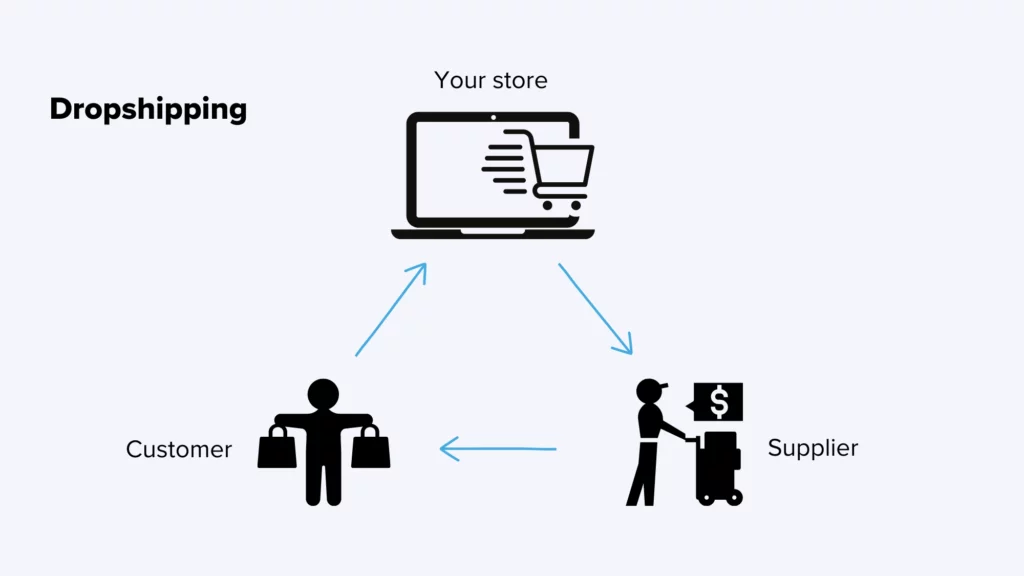
Drop shipping works where you sell the product to your customer, and then pass on the order details to a 3rd party supplier who will ship the product directly to them. You act as the middleman/woman to enable the sale, and then take the profit for yourself.
Private Label
A private label business is a great way to create a unique product line.
It involves finding a manufacturer who will custom produce and brand products exclusively for you that you can then sell directly to customers on your site or any other platform.
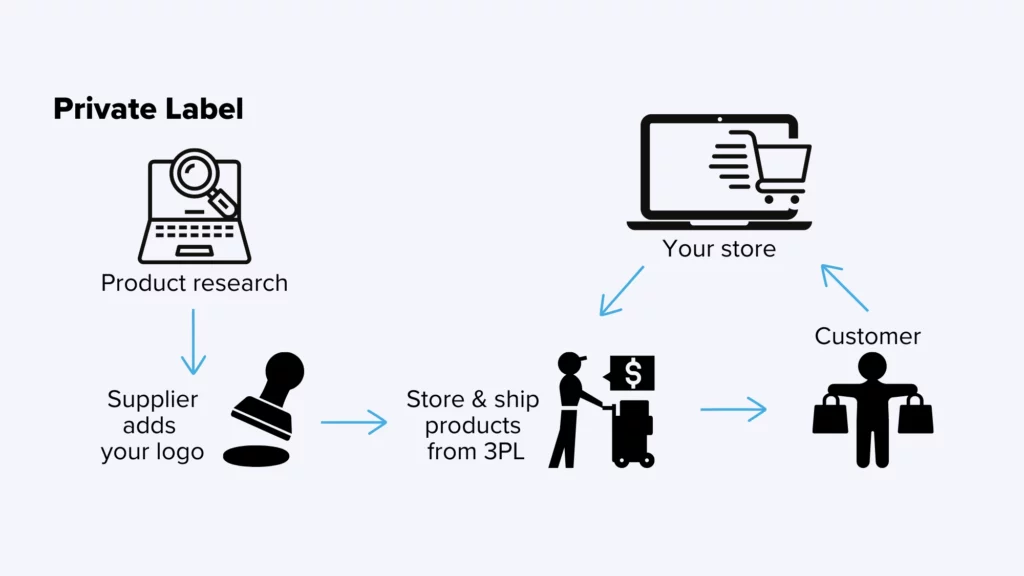
It is up to you as the seller to either fulfill the shipments to your customers yourself, or you could work with a 3rd Party Logistics (3PL) warehouse to handle this for you.
A 3PL would handle all of the storage of your inventory, and handle the shipments to your customers for you once they make a purchase.
Online Arbitrage
Online arbitrage is a popular eCommerce model where entrepreneurs take advantage of pricing differences between different online marketplaces to purchase low and sell high.
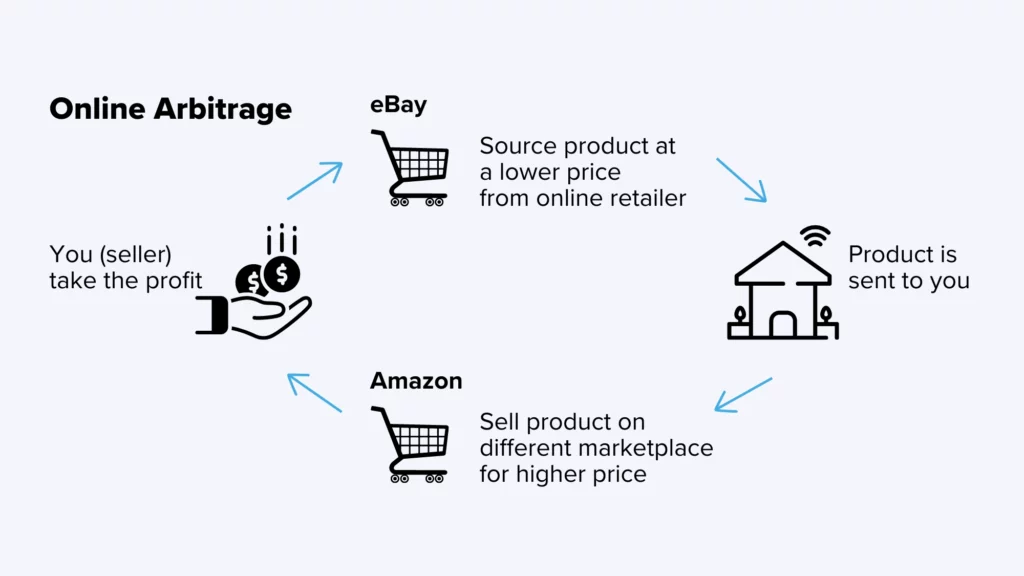
This is done by buying products from one eCommerce store for a reduced rate and reselling them for a profit on another.
Print On Demand
With print-on-demand, you create your designs and upload them to a print-on-demand (POD).
The customer purchases the product from your site, and their order goes straight to the print on demand company who will fulfill the order on your behalf.
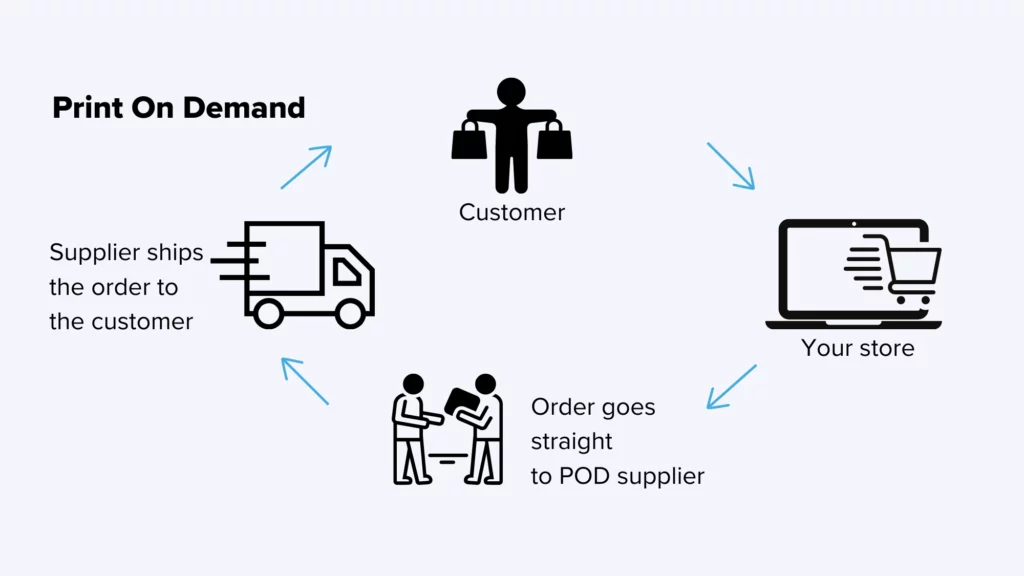
This is a great way for entrepreneurs with limited resources to enter the eCommerce market without needing to buy and store any inventory upfront.
Handmade or Vintage Goods
If you are creative enough to be able to produce your own unique products, then for example an Etsy store might be the perfect eCommerce business model for you.
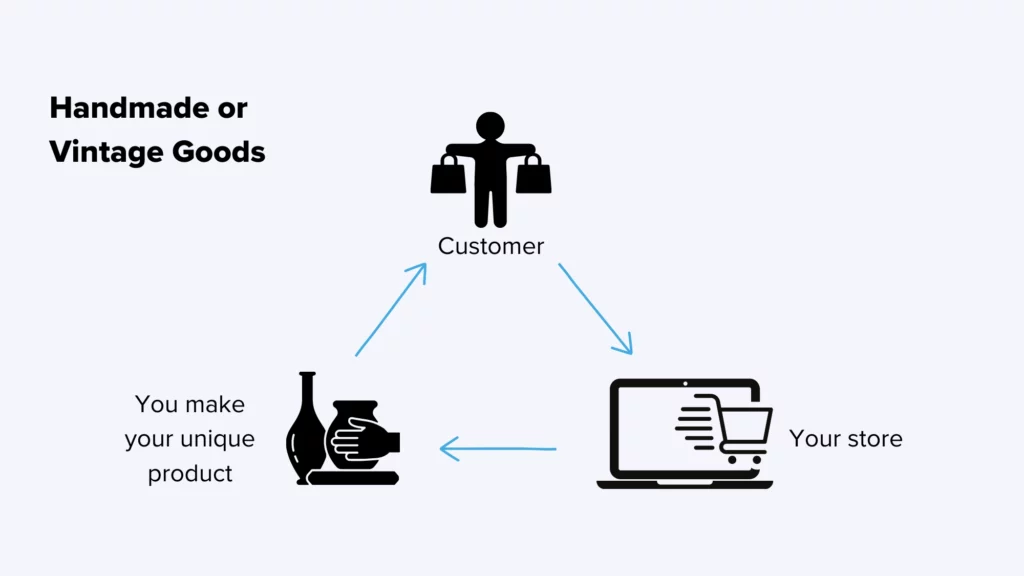
It would be difficult to do at scale as you’re limited to your production turnaround times, but a store like Etsy might be a great way to get your products in front of large potential customers looking for handmade products.
How to Create eCommerce Business Plan (That Actually Works)
Product Research: eCommerce Business Ideas
When starting any business, your lifeline is your cash flow. With this in mind, I’d always recommend starting small with your first product, and then scaling from there.
When I say small, I mean:
- Small physical size of the package
- Low Recommended Retail Price – RRP
- Low numbers of inventory that you invest in to start

Here are some attributes of a good first product:
- Solves a problem for your potential customers
- There is a clear demand for the product
- Easy to source and ship
- Ability to generate a profit
- Durable and unlikely to break
Pro Tip
Are you considering selling your products via Amazon but don’t know if it would be profitable?
Check out our blog post about 5 Best Amazon FBA Calculator Tools! Learn how to figure out exactly how much money you would making on each sale, how much it will cost you to ship your products to Amazon and more.
Validating Your eCommerce Business Idea and Product
Validating your product idea is a vital part of the product development process.
After all – it would be very difficult starting a business with a product that:
- Has low demand
- Has legal restrictions
- Market oversaturation
- Patent issues
- Hazmat Issues
- Import Issues
- Products that require FDA approval

“My number one tip for someone who wants to start an ecommerce business is to focus on the needs and problems of the target audience. Make sure that your product or service really meets those needs or solves problems.
Many successful e-commerce businesses have specialized in a specific niche or audience by offering products or services tailored to their needs. It is therefore crucial to deal with the target group and their needs in detail in advance. Help yourself with market research, surveys, or discuss it with potential customers.
Design your offer so it meets as many needs of the target group as possible and solves them in the best possible way. The quality of the product or service should always come first to build long-term customer relationships.
Focusing on the target audience can also differentiate you from the competition and build a loyal customer base that will happily come back and recommend your company.”
— Christian Helgert, CEO, DOCARI
It’s a good idea to avoid all electrical products too. Any electrical faults would have to be covered under a manufacturer’s warranty, meaning lots of potential returns and negative reviews.
For the same reason, I would also avoid fragile products, that have lots of moving parts, or that are complicated to use.
A simple way to check that your product idea is a good one is to look to see if there are any competitors. If other sellers are selling a similar product, then there is probably demand for it.
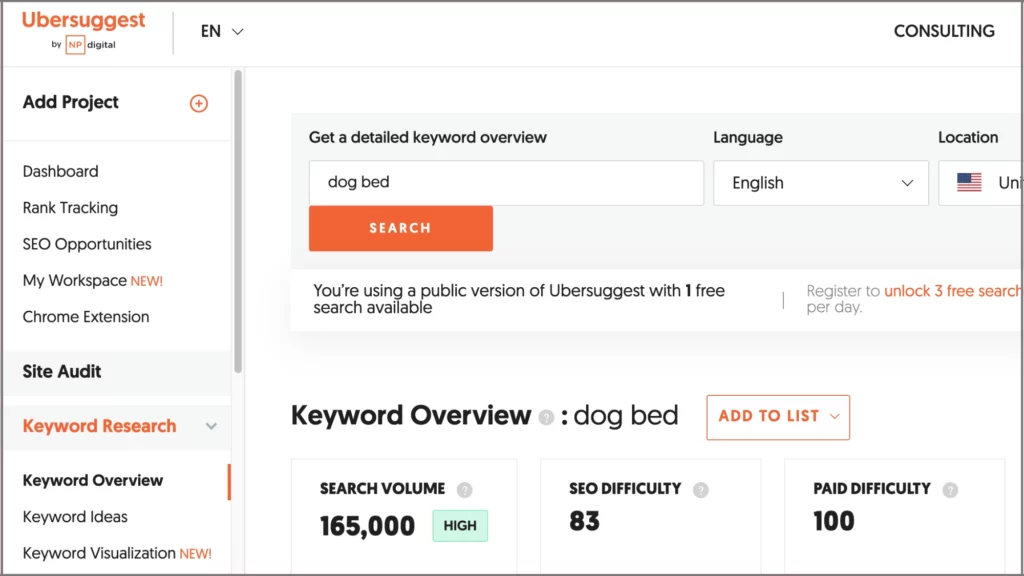
Another, more advanced way to check a product demands to see how many keyword searches this product gets on search engines.
You can do this by entering your main product-related keyword into free tools such as:
- Google keyword tools
- AnswerThePublic
- Ubersuggest
Another way to check demand is to use Amazon and manually find a product similar to yours, and check out the Best Sellers Rating (BSR) stats. The lower the number, the more sales are being generated.
Get To Know Your E-Commerce Competition …
… and learn how to beat them!
Keeping a close eye on your competitors is one of the best ways to perform market research (unless you are creating a product that has never existed before).
Here are some tips for getting to know your competition and benefiting from them:
- Research their products, services, and brand. Find out what they offer and how it’s different from yours.
- Identify their target markets, preferred customer types, and purchasing habits. This can give you insight into where you have an edge over them.
- Stay up-to-date on the latest trends and pricing strategies of your competitors. Monitor their marketing campaigns to see which strategies work best for them.
- Analyze data such as sales figures, website traffic, customer feedback ratings, and more to find out what they’re doing well — and not so well — so you can capitalize on those areas of improvement.
Ask customers why they chose your competitors over your business and use that feedback to further refine your product offering or improve customer service.
“As the founder of an e-commerce company, you should make absolutely sure that you have your own protected (!) brand. Your advantages over the competition should be easy to explain. Just hanging out on the web as a retailer and wait for customers to find you no longer works.
When calculating prices, you should also be clear about the channels you want to serve. It’s quite another thing to compete only on marketplaces if you then also want to supply retailers. It’s also important to always have two main suppliers so you don’t depend on only one.”
— Philip Wagner, Chairman, EnergyBalance AG
Amazon product listings are also a fantastic resource for market research.
If there is a product listed on Amazon that is close to yours, check out the reviews on the listing to see what customers liked, what they didn’t and, and you often find actionable tips from customers on how the product could be improved upon.
Choose Your eCommerce Business Name and Branding
Choose Your Business Name
From experience working with eCommerce sellers, I often find that people who are starting get far too hung up on creating the perfect business name.
It’s not as vital as you may think!
Imagine if Steve Jobs thought that naming the world’s biggest tech company after a popular fruit would be a bad idea.
Jeff Bezos named Amazon because he liked the idea of the company being named after the largest river in the world.

I named my first eCommerce brand after my mothers’ maiden name, and it became a big success (not because of my mum’s maiden name).
But if you’re struggling to come up with business name ideas, here are some questions worth answering to help you get there:
- What does your product do?
- What does your business stand for?
- Is it easy to spell/remember?
- Will it limit you as your business expands?
- Is the .com domain available?
- Are you proud to say the name out loud?
Choosing Your Branding and Logo
After deciding on your business name, you should also think about the overall look and feel of your branding and color palette.
The type of logo you choose will set the tone for how customers perceive your business, so it’s important to get this right from day one. You can hire a professional designer to create something unique for you or use a tool like Design Crowd or Logo Maker to create a custom logo.
“Start building your brand from day one. Dedicate it a one-time budget of around 3000€. I’ve been doing online trading since 2003, and despite all the ups and downs, my brand was and is THE driving force in the company.”
— Jens Hammer, CEO, Grenda & Hammer
Remember, you want something that is memorable and speaks to your target market. Also, take into account the colors and fonts you use in your branding. This will help ensure consistency throughout all aspects of your business.
eCommerce Planning Process – Know Your Goals And Expectations
eCommerce Business Plan or Goal Setting?
Once you have a product idea and a name, now you can focus on planning for success.
The road to success can be a tough one, with twists and turns along the way, so it’s important to have an idea of where you are heading to stay on track.
This can be in the form of an official eCommerce business plan, setting key performance indicators, or simply writing down your goals and aspirations.
“Establish the product that you would be selling and understand why are you gonna sell that product. Understand the market and environment that you are getting in. See which opportunities the market has that the competitors are not filling in and try to find how you can have an advantage over the competition. Creating an identity is also important in order to generate brand awareness to your future buyers and clients.”
— Priscila Aranguiz, PPC Amazon Marketing Manager, subtel GmbH
Whichever way you prefer to plan, these plans should be detailed and specific – make sure that you have measurable goals that can help you track your progress, and celebrate your wins!
Timeline To Success In Online Retail
Setting timelines for when you plan to achieve each of these goals is vital.
Having hard deadlines for vital tasks, and softer deadlines for the less important tasks will give you a way to measure your success over time and ensure that you are staying on top of your business strategy, and prioritizing the more important aspects of your business.
I like to use the SMART goal-setting system:
- Specific
- Measurable
- Attainable
- Relevant
- Time bound

Finally, it’s important to be realistic when setting these goals. Don’t set yourself up for disappointment by setting unattainable objectives!
Work Backwards From Your Goals
It can also be useful to reverse engineer your success.
If you have a monthly revenue target, figure out how many products you would need to sell to achieve this figure, and then decide how you are going to sell ‘X’ amount of your product.
Doing this helps you to realize how achievable your goals may be when you break them down into smaller goals.
“1) Sell a product that has enough margin. I think founders underestimate the cost of selling in the e-commerce world. Even on Amazon you’ll have to pay a minimum of 15% to the platform. Additionally, you’ll need advertising to drive traffic and maybe an additional 20-30% of your margin will be eaten up by ads.
2) Focus on an omni channel approach. Go where your customers are, it may be on traditional marketplaces like Amazon, eBay, Etsy, etc, but also social media or wholesale should always be a part of the business plan.”
— Jonathan Ernst, Co-Founder, Barrel Aged E-Commerce
For example – If you have a revenue goal of $5000 in sales per month and your product costs $25. You would need to generate 200 sales per month or 6.6 sales per day.
Breaking your targets down into daily wins seems far less overwhelming and much more achievable.
How to Set Up an eCommerce Store
In the same way that there are many different types of eCommerce businesses, there are also many different eCommerce platforms to host your online store.
The most popular platforms to start an eCommerce store are Shopify and Amazon FBA.
Shopify is an extremely intuitive and user-friendly platform to build your eCommerce site where you can sell products.
Start an eCommerce Business on Amazon
Amazon is a fantastic platform to launch an eCommerce business because there are already millions of shoppers searching for products with their credit cards in hand.
Amazon also provides you with all of the data that you would ever need to check if your product idea is going to sell, as you can use all of the other sellers’ listings to gauge how much product they are selling daily.
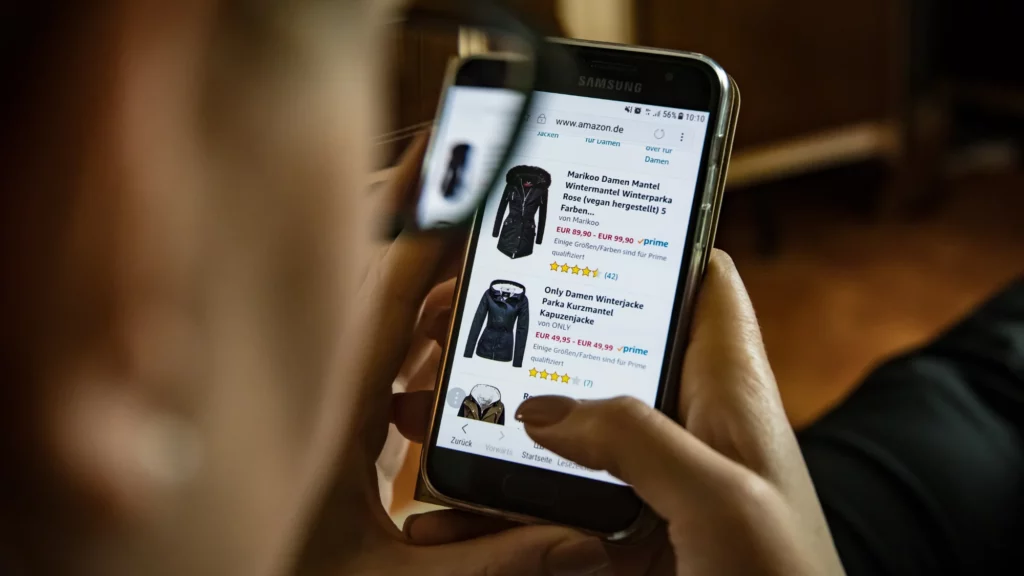
Dropshipping business – the following platforms are great:
- Shopify
- Square
- Bigcommerce
- WordPress using WooCommerce
- Web.com
For a Private Label business, the following platforms are great:
- Shopify
- Amazon FBA
- eBay
- Bigcommerce
- WordPress using WooCommerce
For an Online Arbitrage business, the following platforms are great:
Host your eCommerce store on:
- Shopify
- Bigcommerce
- WordPress using WooCommerce
Source your Online Arbitrage products from:
- eBay
- Target
- Argos
- Walmart
- Disney Store
- Home Depot
For a Print On Demand business, the following platforms are great:
- Printful
- Printify
- CustomCat
- SPOD
- TPop
- Jetprint
For a Handmade or Vintage business, Etsy is great. There are more of them out there but Etsy is definitely the biggest and most global one.
Build Your eCommerce Store
If you’re new to building websites, some great no code website builders are very user-friendly which makes the process a lot simpler.
However, the learning process would be slow, taking away precious time from getting your business operational.

“In business I feel it’s necessary to have a few key elements. You obviously need a good product that can sell. You need a good process to keep organized and handle all the logistics. But most importantly you need good people around you.
Find someone who will be loyal to you and the business and be just as loyal back to them. Don’t let them call you Boss, lol. Don’t make them be just an “employee”. Make them feel like they are an integral part of the business.
Respect them, respect their opinions, respect their time, respect their families. This will come back 10 fold in how hard they work for you. And it will make your place of business somewhere people look forward to going everyday.”
— Jake Stanislawski,
Partner at Barrel Aged E-Commerce and Owner of Northland Frames and Gifts Inc
How to Generate More Sales In Less Time
Before you start looking for customers, you first need to know who they are, where they’re hanging out, and what drives them to purchase your product.
You can easily figure out demographic trends for your products by leveraging your competitor’s data with tools like SimilarWeb.
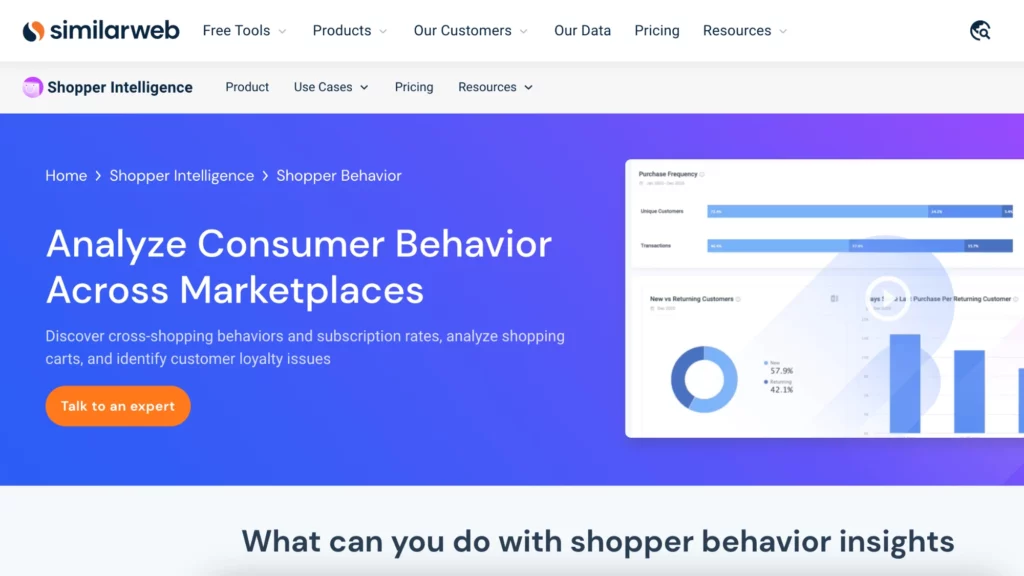
Marketing To Your Customers
The next step would be creating a marketing strategy and getting your product in front of your target customers.
This is where the pay-per-click (PPC) optimization tools play a huge role in generating highly targeted sales early on in your eCommerce business.

“If you want to start an e-commerce business, first establish what your vision and mission is. Why do you want to create an e-commerce business or sell those specific products?
The idea of creating an e-commerce business just because “more and more people are buying online” is tempting, but that is not enough to be able to define your strategies and gain a competitive advantage that will make customers buy from you and not from others.”
— Virginia G. Diez, PPC Amazon Marketing Manager, subtel GmbH
Whether you are starting a dropshipping business on Shopify and want to run PPC ads on Google, or have decided to sell products on Amazon and want highly optimized Amazon PPC ads. Adspert will ensure you are maximizing profits by keeping the cost of sale as low as possible. Try it out for free and see for yourself!
Getting Your First Sales
If you don’t have a marketing budget, the best way to generate your first few sales is to offer your product at a discounted rate to your family and friends.
Leveraging your connections is a great way to get the word out about your new venture. You could email your contacts, or run a free giveaway competition on your social media channels.
“Do not allow failure to define you. Treat every failure as a step towards your growth and success. Do not be afraid to fail, and do not let past failures cloud your current and future judgement. Treat every win and loss as an opportunity to learn.”
— Aleks Migdalovich, Amazon Expert, AM Design & Consulting LLCr
Creating TikTok videos showcasing your product’s benefits and features is a fantastic marketing strategy to attract customers for free.
If you make the video entertaining and engaging enough that other TikTok users want to share your video, there’s a chance it could go viral and this is great exposure for your brand and business.
Starting An eCommerce Business: The Legal Part
When starting an eCommerce business, there are some legal considerations to keep in mind.
First and foremost, you will need to register your business with the necessary authorities. This may include registering with a local government authority or creating a company under the laws of the country you reside in.
You should also research and understand any laws that relate to online selling, ensuring you are complying with local regulations. This could include any data privacy and consumer protection laws.

It depends on the country and origin of your business as this will be different around the world, but it would be beneficial to look into the legalities of registering a business in your area.
Some things to look into might include:
- Business licenses
- Professional and trade licenses
- Business permits
- Intellectual Property rights
- Patents or copyrights
It’s also important to have a solid set of Terms & Conditions or Return Policies in place so your customers know what they are agreeing to when they purchase from you.
Secrets of the Most Profitable Web Commerce Businesses
If you guessed “money”, you are right! Successful eCommerce businesses are usually the ones that mastered their cash flow.
It may sound easy, but cash flow for web commerce can be a tough monster to tame at times.
You’ll rely heavily on a constant flow of cash coming in and out of your business to keep the wheels moving and allow your business to keep running smoothly and effectively.
It’s good practice to separate your personal and business finances by setting up an LLC (if you’re already generating income) early on to avoid running into personal financial issues further down the line if anything bad were to happen to your business.

One way to manage your cash flow is by creating a budget that’s tailored specifically for your eCommerce business.
This should include all of your expenses from running the business, such as:
- Hosting fees
- Payment processing fees
- Advertising costs
- Employee salaries
- And all other costs involved with running your business
It’s important to be mindful of your budget and stick to it as much as possible. This will help you to avoid any cash flow problems and allow you to reinvest your profits back into growing and scaling your store to reach new levels of success.
“Start with due diligence and verify as thoroughly as possible that you have a product that matches demand and is providing as much unique value as possible and customers are willing to pay for (enough to leave you margin for investing into growing, you will need that). Everything else is easier to improve on and get support for.
When operating with D2C model, each sale has its costs. Calculate your margins carefully and leave room for investing into sales growing activities.
eCommerce is ultimately very democratic which means there are less barriers of entry but at the same time less support from stakeholders as in let’s say traditional retail.
eCommerce provides a lot of transparency for consumers in terms of their options. The one who is best at showing the value they bring to the end customer, is the most likely winner.”
— Ilkka Puumala, Co-Founder, COO, Dash Retail Consulting Ltd
Finally, don’t forget to account for tax in all of your financial plans. Make sure that you research what taxes apply to your eCommerce business, and how much you need to set aside to cover them.
Here are some great ways to look after your cash flow:
- Negotiate the best payment terms with suppliers (lower deposits on inventory will buy you more time and increase available cash)
- Get paid as soon as you can. Some payment services will hold cash for too long, try to avoid this.
- Avoid having too much inventory that isn’t selling. This is cash that could be working for your business, not just sitting on a shelf.
- Reduce unnecessary overheads.
- For international business, agree on the best exchange rates with currency exchange services like TorFX.
Master eCommerce: Take an eCommerce Course
It might be useful to invest some of your start-up capital into a mentorship or a digital course to learn from those who have been successful in the eCommerce space.
Having a mentor or coach to guide you can help to speed up success rates, reduce stress and give you some useful insights into things that would be beneficial for your store, such as marketing strategies and customer acquisition tactics.

You might also want to consider taking an eCommerce online course to be guided on all of the steps that you would need to take, and be shown exactly how to start an eCommerce business.
Investing in courses is a great way to get up to speed on all of the different aspects involved with starting your store and help you avoid any costly mistakes that could cost you time and money further down the line.
Conclusion
Starting an eCommerce business can be an exciting and profitable venture, and hopefully, this post will help to get you further down the path to getting started.
By taking the time to research the different kinds of eCommerce business models, leveraging the best market platforms, and gaining clarity on your expectations and goals before getting started, you can set yourself up for success.
Having a clear and well-executed marketing strategy will help you to get your product in front of the best customers, and will fast-track early sales and growth for your business.
Finally, healthy cash flow is so important for all businesses, especially for startups in the first 3 years. So try to keep overheads to a minimum, and I would always encourage entrepreneurs to try not to draw an income from their new store in the first 12 months (at least).
The longer you can wait for the rewards, the healthier your business will be in the long run, and the greater the rewards will be.

Author
An ex-construction worker, turned multiple 6 figure eCommerce seller. Founder of craig-adam.com waking up frustrated employees and helping them realize that there could be a better way to generate a more scalable income.




